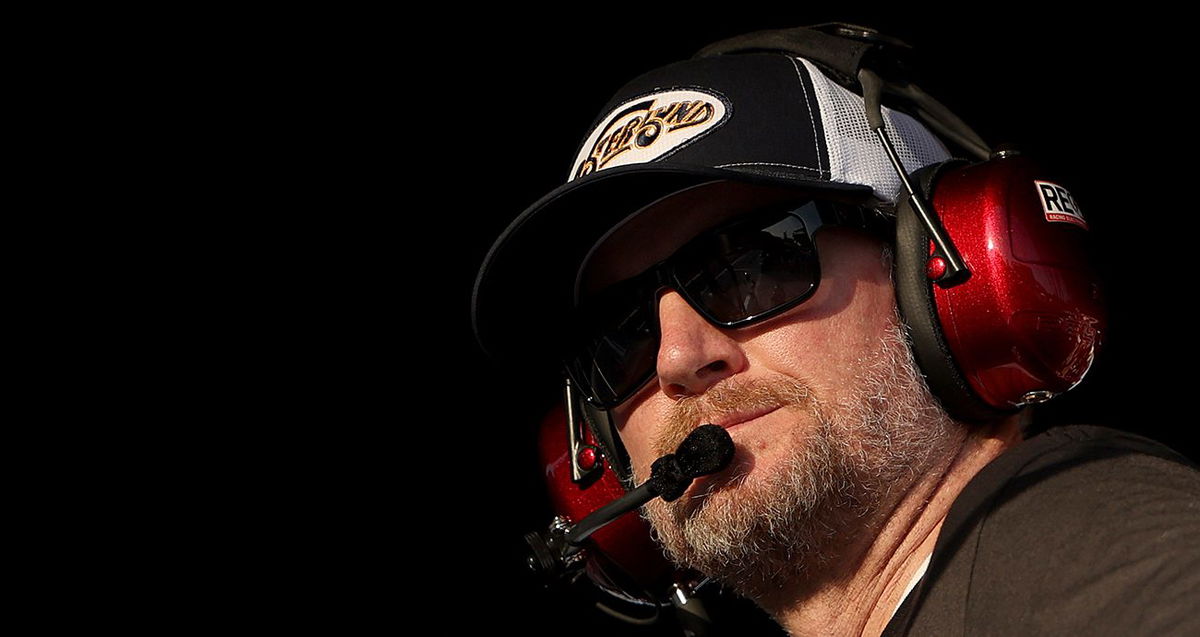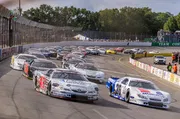
Imago
Dale Jr and Justin Mark in awe over NASCAR rule change

Imago
Dale Jr and Justin Mark in awe over NASCAR rule change
Atlanta Motor Speedway was never Dale Earnhardt’s hometown track, but it became one of his most formidable arenas. It was a true testament to his adaptability and grit at a venue that wasn’t inherently his own. Between 1980 and 2000, The Intimidator dominated Atlanta with 9 Cup series victories, trying his success at Bristol and Darlington.
Watch What’s Trending Now!
Yet, Atlanta of today feels like an entirely different animal, not in the way fans necessarily appreciate. Glossy, broadcast-optimized racing often lacks Earnhardt’s era’s raw, wheel-to-wheel intensity. As fans shift towards spectacle over substance, Dale Earnhardt Jr., ever the mediator, has a few words of his own.
ADVERTISEMENT
Dale Jr. sounds the alarm on stat manipulation
For Dale Earnhardt Jr., the debate around EchoPark (formerly known as Atlanta Motor Speedway) isn’t just about track grip or race package; it’s about legacy. As the Cup series continues to reclassify Atlanta into the same statistical category as Daytona and Talladega, he’s watching his and his father’s history slowly reshaped, distorted even, by a scoreboard that no longer respects the original intent.
In his recent Dale Jr. Download episode, Dale Jr. expressed his frustration. He said, “But now they have lumped in the stats that me and dad had from Daytona and Talladega into the stats at Atlanta of the new configuration of Atlanta. And they’re compiling this sort of statistical, you know, scoreboard, if you will, and at one point Atlanta’s going back to this old, worn-out, non-drafting style of racing; at some point it will that surface.”
The 50-year-old highlights that broadcast is now classifying Atlanta as another drafting track, grouping its results under the same sweeps of tradition won by his father at Daytona and Talladega. But with Atlanta’s grip levels low and lanes opening dramatically, that classification misleads viewers. Imagine attributing Dale Earnhardt’s 1989 win, where he led 294 laps at the Atlanta Journal 500, to the same stylistic realm as plate tracing. The numbers say they are the same; the track for Junior says they are not.
ADVERTISEMENT
The configured Atlanta provides a different brand of racing, pack style, yes, but on the surface, that is progressively losing grip. Junior wants that in just a few years: “ You’re going to go off in the corner and you’re not going to be able to be in that close proximity to the car behind you because of the lack of grip.” That means less tandem drafting and more tire management, more handling issues, and racing that resembles Kansas or Las Vegas, not the clean air chess match that defined the superspeedway skillset Dale Earnhardt perfected.
This comment hits at a real discrepancy. Atlanta was repaved in 2022 to mimic super speedway-style racing, and though it resembles plate racing visually, it’s a vastly different base. The track surface is rapidly losing grip, creating lane-based and handling-dependent racing, not pure drafting chaos, but still being packaged as traditional restrictor plate racing.
ADVERTISEMENT
His warning is validated by recent data showing aging asphalt in Atlanta leading to tire degradation and broken lanes, drivers must lift in turns and speed out, unlike the ball of cars dynamic scene at Daytona and Talladega.
“And so they need to, they just need a way to be able to give you statistics about whether this driver is good at this style of tracks, where, you know, the racing is similar. And you know, but without really altering the scoreboard, if you will. So, um, Austin Hill is a hell of a race car driver and damn good at Daytona, Talladega in Atlanta. But yeah, I’m conflicted on what do we, you know, we’ve added this Atlanta race into that restrictor plate track sort of scoreboard, and now eventually it’s coming back out, and it’s not a statistic.”
This exchange is a key point: they are not merely talking semantics. They’re criticizing how stats, once a reliable measure of skill, are now squashed to boost broadcast narratives. Adding Atlanta to the restrictive plate track statistic obscures what Dale Earnhardt achieved at Daytona and Talladega.
ADVERTISEMENT
Junior dismantles the process behind the classifications: “It’s not a statistic that’s like, you know, who decides when what happens? That’s not a governing body decision… That’s decided by some stat guy, I suppose, or some network executive in a production meeting… Well, should we not call at that anymore, alright? We got enough votes in the room. Okay. We won’t call it that anymore this week.”
In short, Atlanta’s identity and, by extension, The Intimidator’s legacy are being flattened by broadcast-driven convenience. Instead of firm data, the narrative is dictated by who wins the meeting room vote that week, not by what racers endure on the track.
Denny Hamlin echoed Junior’s observation, drawn in by the race’s modern chaos, the 23-car wreck fest. On his Actions Detrimental podcast, the No. 11 driver says, “Atlanta, you can’t see it on TV, but the cars are sliding all the way through the corner. You can’t run right behind somebody in the corner… then, that creates a gap. Somebody gets a run, boom, takes your gap. So, the fantastic racing was just a perfect combination of everything that had happened between the car, the track, and that wreck.”
ADVERTISEMENT
Hamlin admitted to feeling serious post-race FOMO, his Cup series team shaken by that car crash that defined stage two and shifted the tone, as he notes it to be the “ best thing” for spectator drama. He admitted being baffled by scoring decisions he felt undervalued his actual race position and efforts in fixing the damage. Through Hamlin’s eyes, Atlanta feels disjointed and more of a product of track engineering and broadcast packaging than a true Driver versus Driver legacy. But at least there are other ways he is protecting his legacy.
Top Stories
‘NASCAR on Sale’: Team Owners Interested to Buy Out France Family With $5B Price Tag

‘RIP’: NASCAR World Crumbles in Tears as 39-YO Former JR Motorsports Driver Passes Away

NASCAR Champ’s Desperate Plea Got Rejected as Snowball Derby Official’s Bizarre Confession Sparks Outrage

NASCAR Hits Back at Michael Jordan & Co.’s Key Witness After Shocking ‘Bankruptcy’ Claims

Carson Hocevar Shuts Down NASCAR Star’s Embarrassing Snowball Derby Tantrum in Blunt Social Media Takedown

Dale Jr. is keeping his legacy alive through philanthropy
Long before NASCAR rolled out its Driver Ambassador Program, several drivers were already going the extra mile with initiatives in their communities. And with Joey Logano winning the first DAP term, there is a palpable and renewed energy among drivers to broaden the sport’s reach, many rallying behind Dale Earnhardt Jr.’s Driven to Give campaign.
ADVERTISEMENT
The Driven to Give campaign, spearheaded by the Dale Jr. Foundation, raises funds for Nationwide Children’s Hospital each year. Highlighted by the iconic skeleton glove initiative, NASCAR drivers don custom gloves during races to boost awareness and donations.
Recently, Ryan Blaney spotlighted his effort on Instagram, sharing a snap of the skeleton print gloves, saying, “The Driven to give proceeds benefit the Dale and Amy Earnhardt Fund at Nationwide Children’s Hospital.” Urging fans to bid on autographed gloves, enhancing community visibility for the course.
During the Atlanta race weekend, 70 Cup and Xfinity drivers participated, wearing Junior-inspired gloves to support Nationwide Children’s Hospital. Among those joining were Michael McDowell, William Sawalich, Carson Hocevar, Erik Jones, Ty Gibbs, Christopher Bell, and Brad Keselowski; each pair was signed by both the driver and Dale Jr. before being auctioned on July 1.
ADVERTISEMENT
Ryan Blaney’s race-worn pair, signed by both him and Dale Junior, will include a Certificate of Authenticity from JR Motorsports. Proceeds support the Dale and Amy Earnhardt Fund, benefiting pediatric patients through rehabilitation, prevention, and critical research.
Since its 2017 launch, Driven to Give has raised over 2 million. And 2024, the 14th annual Gala, hosted at Dale Junior’s Whiskey River and presented by Bass Pro Shops, raised over $460,000, bringing together 320 guests, live auctions, and performances by Chris Janson. This campaign not only honors Earnhardt’s legacy through action but also connects next-gen fans via shared perfect purpose, a living legacy beyond the racetrack.
ADVERTISEMENT
ADVERTISEMENT
ADVERTISEMENT

